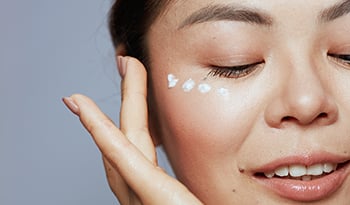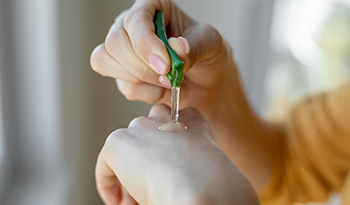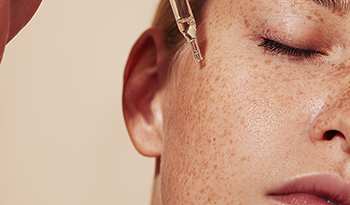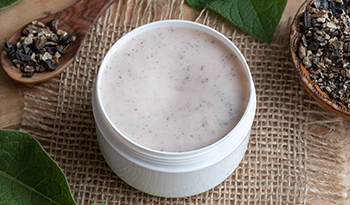4 Benefits and Use Cases of Witch Hazel
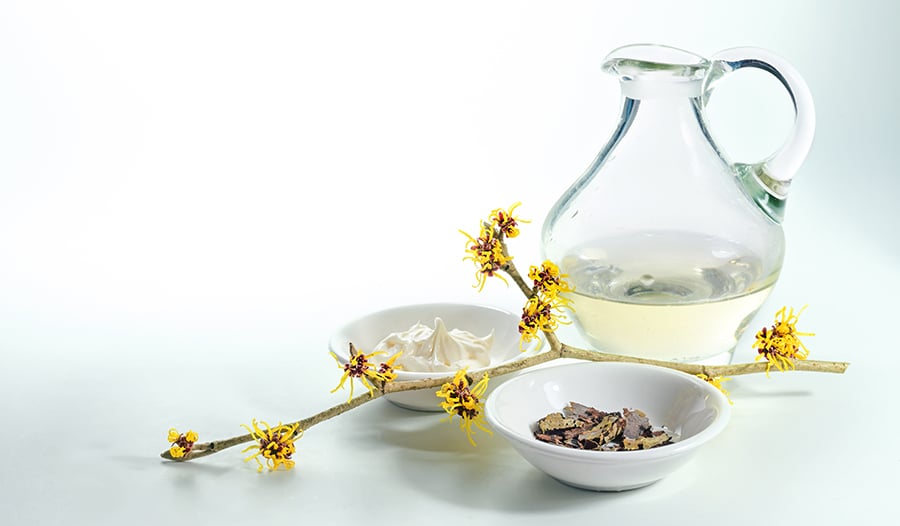
What Is Witch Hazel?
Witch hazel is a topical astringent with a variety of skin benefits. It is made from the leaves, bark, and twigs of the witch hazel plant, Hamamelis virginiana, which grows in North America. Witch hazel may be on your radar lately, as it has become a popular staple of skin care routines. While witch hazel helps improve skin appearance, its perks don’t stop at shrinking pores and fighting acne-causing bacteria.
Read on to learn the skin and scalp benefits of witch hazel, how to use it, potential side effects, and why you should consider incorporating this simple product into your wellness routine.
4 Benefits of Witch Hazel
Witch hazel is a clear liquid commonly applied topically to the skin using a cotton pad. It offers an array of benefits for the skin and scalp, including helping calm acne, soothe sensitive scalp, and reduce skin inflammation and irritation.
Because of witch hazel’s varied medicinal properties, manufacturers have developed products beyond the water-like astringent, including ointments and even teas containing witch hazel. While topical use of witch hazel provides well-documented benefits with few, if any, side effects, ingesting witch hazel may pose more risk. Whether you are looking for ways to manage skin irritation or inflammation or have a condition that causes scalp sensitivity, adding witch hazel to your daily routine may be a simple solution to your beauty woes.
Skincare
Acne is a common skin condition characterized by skin inflammation. With acne, hair follicles become clogged with oil and dead skin cells, leading to pimples that may be painful and aesthetically bothersome.
Acne may be caused by a variety of factors, including hormones, cosmetic products, weather, and certain medications. Countless products, medications, and therapies claim to help resolve acne—often without success.
Thanks to its anti-inflammatory and astringent properties, witch hazel may be an effective, natural component of an acne-fighting skincare routine. As a powerful astringent, witch hazel contracts skin cells and pores, helping to keep out acne-producing bacteria.
You can apply witch hazel directly to your skin after cleansing or use acne-specific products containing witch hazel. While research on witch hazel’s effect on acne is limited, its use as a treatment seems promising, especially for those with oily skin types.
The foods you eat can also affect your skin and may exacerbate acne. Foods that cause a quick rise in blood sugar and, over time, promote insulin resistance may be a culprit. Processed carbohydrates, like sugary cereals, white bread, sweetened granola and cereal bars, and sugar-sweetened beverages, are some of the foods and drinks most likely to cause a blood sugar spike.
Instead, choose foods with a high fiber content and minimal added sugar, like oatmeal, crackers, pasta, quinoa, and other whole grains. These foods are less likely to result in a blood sugar spike. Additionally, lean proteins, fruits, veggies, and nuts and seeds should comprise a large portion of your diet.
Scalp Sensitivity
Scalp sensitivity can be caused by dermatological concerns like psoriasis or dermatitis or from certain hair treatments or products. Dandruff, scalp itch, and excessive oiliness are some of the most common complaints related to scalp sensitivity. Luckily, addressing these symptoms doesn’t require much time, money, or product—they can often be improved with a simple yet effective scalp care routine.
Witch hazel may help soothe scalp sensitivity by relieving scalp irritation, though research is limited. In one study, people with scalp irritation who used a witch hazel shampoo for four weeks experienced improved scalp sensitivity and irritation.1
It may be easy to forget about your scalp under all that hair, but the scalp is a unique type of skin that requires its own care. Caring for your scalp may be as simple as switching to a witch hazel shampoo and conditioner.
Anti-Inflammation
Inflammation is your body’s natural protective response. While acute inflammation in response to injury won’t negatively affect your body, chronic inflammation is more concerning. This type of inflammation is influenced by numerous factors, including diet and other health conditions, and could lead to its own set of health problems if not controlled.
Witch hazel can help soothe topical inflammation caused by skin irritation from a mild sunburn. The tannins in witch hazel have anti-inflammatory properties and may be able to ease the discomfort, swelling, and tenderness of a sunburn. Simply apply witch hazel to a cotton pad and gently swipe over your sunburn.
Aloe vera is another natural product that can help ease inflammation from sunburn. Some products combine aloe vera with witch hazel for amplified relief. Whether you are headed to the beach soon or need to stock up on summer outdoor essentials, be sure to keep after-sun care products on hand to help soothe your skin after a day in the sun.
Skin Irritation
Witch hazel’s anti-inflammatory properties may also help ease discomfort and speed healing of rashes. Applying witch hazel directly to irritated skin may help reduce itching and burning discomfort and ease sensitive skin.2 You can also apply a lotion containing witch hazel to your skin.
Eating the right foods may also help improve sensitive skin. Foods rich in essential omega-3 fats, like tuna, salmon, and walnuts, may help improve inflammatory skin conditions and support healthy skin.3 Taking an omega-3 supplement daily may help address persistent skin irritation. Avocados, tomatoes, and bell peppers also contain healthy fats and micronutrients like zinc and vitamin C that support healthy skin.
How to Use Witch Hazel
Witch hazel is most often used topically. To treat acne, scalp sensitivity, sunburn, or skin irritation, apply witch hazel directly to the affected area using a cotton pad. You may also use specially formulated products that contain witch hazel, like lotions or shampoos.
While some people use astringents like witch hazel as a mouth rinse to treat canker sores, internal use of witch hazel may cause upset stomach or other more serious health issues. It’s best to avoid ingesting witch hazel to prevent possible harmful side effects.
Common Side Effects & Health Risks of Witch Hazel
Witch hazel is generally considered safe and without side effects when used topically for skin conditions. Ingesting large amounts of witch hazel orally may cause serious complications and should be avoided.
While there aren’t any known interactions between witch hazel and other foods, supplements, or medications, it’s always a good idea to check with your doctor before introducing a new ingredient into your wellness routine. If you’re considering using witch hazel for skin issues, consult your dermatologist to be sure it is right for your skin’s needs.
Takeaway
Witch hazel is a natural astringent that may help soothe a variety of skin conditions. From sensitive and irritated skin to scalp sensitivity, topical use of witch hazel is a safe, affordable remedy. Look for witch hazel as a stand-alone product or incorporated into specially formulated lotions or shampoos.
While witch hazel is generally free of side effects when used topically, it’s always a good idea to consult your healthcare team before introducing a new product or supplement into your skincare or wellness routine.
References:
- Trüeb R. North American Virginian Witch Hazel (Hamamelis virginiana): Based Scalp Care and Protection for Sensitive Scalp, Red Scalp, and Scalp Burn-Out. Int J Trichology. 2014;6(3):100.
- Heinicke IR, Adams DH, Barnes TM, Greive KA. Evaluation of a topical treatment for the relief of sensitive skin. Clin Cosmet Investig Dermatol. 2015;8:405.
- Thomsen BJ, Chow EY, Sapijaszko MJ. The Potential Uses of Omega-3 Fatty Acids in Dermatology: A Review. J Cutan Med Surg. 2020;24(5):481-494.
DISCLAIMER:This Wellness Hub does not intend to provide diagnosis...













































































 Table of Contents
Table of Contents




